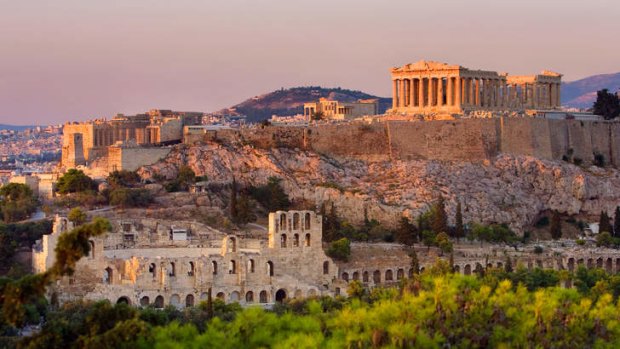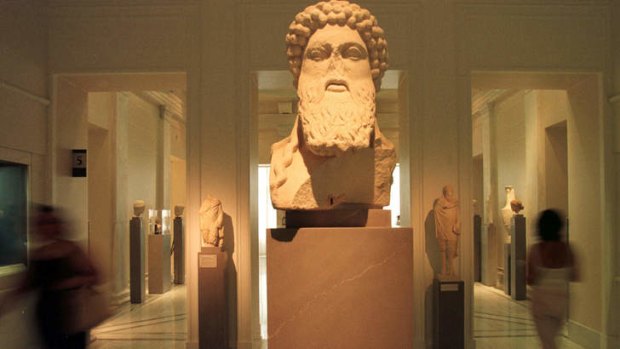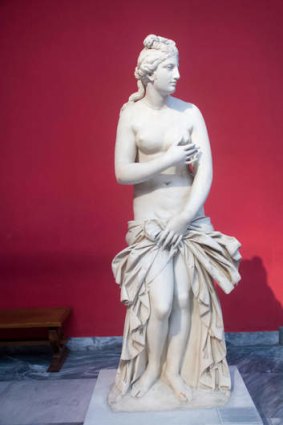
Ancient riches: the Acropolis of Athens.Credit: Corbis
Greece may be down on its luck, but Athens, so rich in history, has not lost its wow factor, writes Jane Foster.
Magnificent ancient monuments, several outstanding museums, a plethora of authentic cuisine and a blissful Mediterranean climate: Athens makes a rewarding visit at any time of year.
It has received plenty of negative press over the past two years, and while there is no doubt the global economic crisis has hit the population hard and there are still plenty of political and economic problems to be solved, Athens is still a fully functioning capital and the situation has been more stable recently. For visitors, it remains a beautiful place, packed with cultural attractions and rich in street life.

Visitors walk past a marble double herm on exhibit in the renovated Benaki Museum in Athens.Credit: Reuters
We have picked 10 of the best sights in and around the centre. Downtown Athens is compact and most of the main attractions are within easy walking distance of one another. If you need to get about quickly, the modern three-line metro system is inexpensive and easy to navigate, connecting the airport, the port of Piraeus and the city centre.
THE ACROPOLIS
Few travellers will want to miss this, the most potent symbol of the founding of Western democratic government. The monuments of the Acropolis rock dominate the skyline above the heart of modern Athens. The largest and most impressive building, the fifth-century BC Parthenon, is considered one of classical architecture's most influential structures, but not all of the key sites are on the hilltop. The 4-kilometre Archaeological Promenade skirts the foot of the Acropolis, connecting it to other important attractions, most notably the Acropolis Museum and the Agora. See odysseus.culture.gr.

A marble statue of Aphrodite, the godess of love and beauty, National Archaeology Museum.Credit: Alamy
ACROPOLIS MUSEUM
A 10-minute walk from the Acropolis, this light, airy glass-and-concrete building was designed by Swiss architect Bernard Tschumi. A magnificent collection of ancient statues is displayed here, while pride of place, on the top floor, goes to a reconstruction of the marble frieze that once ran around the top of the Parthenon. The missing pieces, most of which are now in the British Museum, have been substituted by plaster copies. On the second floor, the cafe-restaurant (see Five for lunch, right) is a fine spot for lunch with an Acropolis view. See theacropolismuseum.gr.
NATIONAL ARCHAEOLOGICAL MUSEUM
Fully renovated for the 2004 Athens Olympics, this purpose-built 19th-century museum has a marble-floored interior, which shows off its magnificent collection of ancient and classical Greek artefacts to maximum effect. It's vast and each section houses the collection from a specific archaeological site.
Top exhibits include the golden Mask of Agamemnon. Another attraction, the Antikythera Mechanism, a first-century BC bronze device believed to have been used to predict lunar and solar eclipses, is on display until January 2014. There's a pleasant cafe in the basement opening on to a peaceful internal courtyard. See namuseum.gr.
PLAKA
Built into the hillside immediately below the Acropolis, Plaka is the city's oldest residential quarter. Despite the many tourists, it retains a quaint, small-town atmosphere, its cobbled streets lined with pastel-coloured Neoclassical mansions, small hotels, souvenir shops and bustling tavernas. Located close to all the city's major attractions, it makes an ideal base for visitors. Notable sights include the Museum of Greek Folk Instruments and the 12th-century Byzantine Little Mitropolis Church.
ANCIENT AGORA
During Athens' Golden Age (the fifth century BC), the Agora was the city state's main marketplace and administrative centre. Lying below the Acropolis, today many of the buildings of the Agora are no more than crumbling ruins set amid a pastoral landscape dotted with olive trees, but the second- century BC Stoa of Attalos (which now houses the Agora Museum) and the earlier Temple of Haephaistos remain remarkably well preserved. See odysseus.culture.gr.
BENAKI MUSEUM
Housed in an elegant neoclassical building, this museum offers a full overview of Greek art from prehistoric times up to the 20th century. Sculpture, ceramics, jewellery, paintings, furniture and costumes are on display, but top pieces include the second-century BC Thessaly Treasure (a hoard of gold filigree jewellery set with precious stones), two early paintings by El Greco, and the reconstruction of two 18th-century, wooden-panelled, Ottoman-inspired living rooms. The second-floor cafe-restaurant has a lovely terrace with views of the Acropolis, Mount Lycabettus and the National Gardens. See benaki.gr.
MOUNT LYCABETTUS
See the whole of Athens from the city's highest vantage point (300 metres), capped by a tiny whitewashed church, a restaurant and a cafe. Nearby, carved into the rocks on the north-facing slope, Lycabettus Theatre stages open-air concerts. The steep path up zigzags through pinewoods and subtropical vegetation. Alternatively, catch the funicular from Ploutarchou Street in Kolonaki (every 30 minutes, 9am to 3am). Children will love this too.
BYZANTINE & CHRISTIAN MUSEUM
This open-plan underground exhibition space lies below the courtyard of a neoclassical villa. Tracing the development of the Byzantine Empire from the birth of Christianity to the fall of Constantinople in 1453, exhibits are presented in chronological order, and include early Christian stone carvings, glittering mosaics, religious icons depicting the saints, frescoes illustrating events from the Bible and a hoard of gold and silver jewellery. Occasional temporary exhibitions explore the influence of Byzantine culture on contemporary culture. See byzantinemuseum.gr.
MUSEUM OF GREEK FOLK INSTRUMENTS
In a 19th-century mansion in Plaka, this museum displays a vast array of traditional Greek regional musical instruments. Each exhibit is accompanied by a headset with a recording, so you can listen to the sounds the instruments make. Concerts are held in its walled garden on summer evenings. See Diogenous 1-3.
CENTRAL MARKET
Although many Athenians have succumbed to supermarket culture, traditionalists still shop in the colourful, loud and bustling covered market in the city centre. Housed within a vast iron-and-glass structure dating from 1870, the interconnected halls have sections dedicated to fresh fish, meat, poultry, dairy produce and seasonal fruit and vegetables. See Sofokleous and Evripidou streets, Monastiraki.
Telegraph, London
Sign up for the Traveller Deals newsletter
Get exclusive travel deals delivered straight to your inbox. Sign up now.